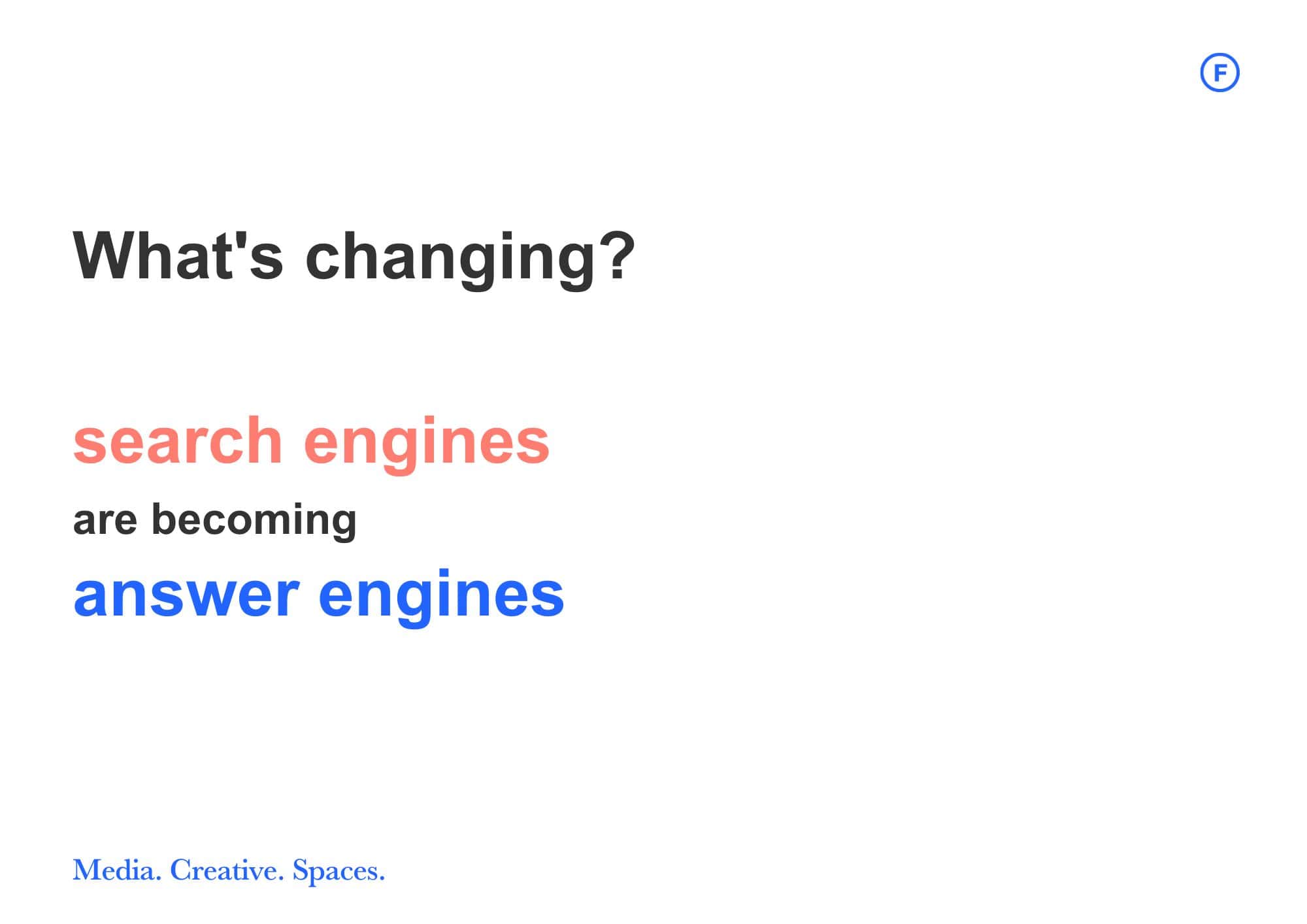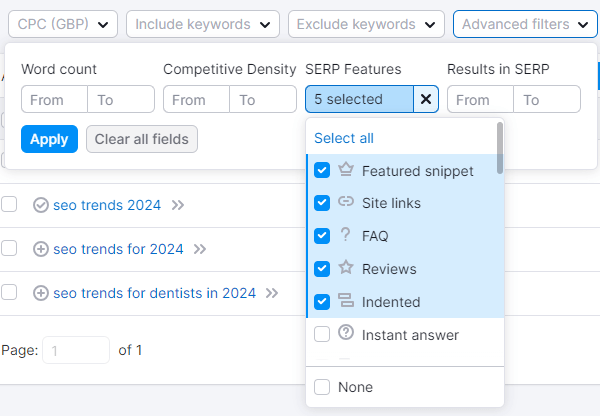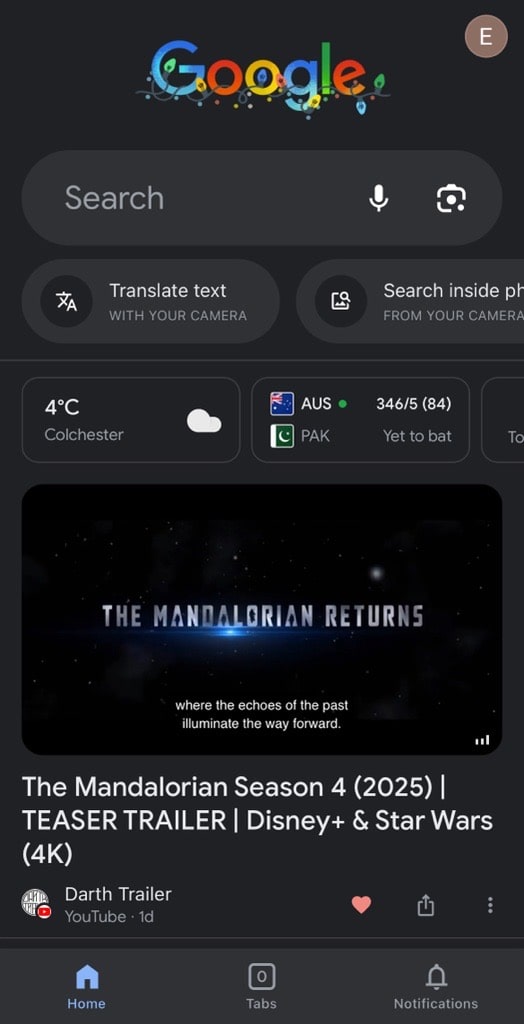2024 SEO Trends and Insights
Stay ahead of the curve with these SEO insights from our specialist, Ehlana Foley.
Stay ahead of the curve with these SEO insights from our specialist, Ehlana Foley.
In the fast-changing world of digital marketing, businesses must stay ahead to succeed. Search engine optimisation (SEO) plays an essential role in driving organic traffic and boosting online visibility.
The future of SEO is especially crucial in the midst of the current digital revolution as SEO technology is making rapid advances. Let’s look at some of the key SEO trends that are expected to dominate the landscape in 2024. I’ll also provide insights on how businesses can adapt their SEO strategies to stay ahead of the competition.
Artificial intelligence (AI) and machine learning are transforming the SEO landscape.
Software such as ChatGPT, Bard, and Google Search Generative Experience (SGE) are making SEO more conversational. Plus, search engines are getting better understanding user intent.
Not only this, but AI software is becoming better at helping us to analyse data faster, gain better insights, and save time so that we can delve deeper into strategy.
One of the biggest discussions in 2023 has been around AI generated content and whether it is good enough. I’m torn on this subject. I wouldn’t ask ChatGPT to write a blog for me and publish it straight to a website without checking it first.
Using AI ethically and responsibly is important in the early stages of this revolution. You should always check work produced by AI thoroughly. The potential for bias and misinformation within AI is no secret in the digital world.
When used for tasks like ideation, generating meta titles and descriptions at scale, or analysing competitors, AI has proven to be invaluable. Concise prompting is the key and I picked up some tips and tricks at BrightonSEO in September 2023 from Aleyda Solis.
Using the “5Ws and the H” method gives clear instruction on what you want to achieve with your prompt.
| What [is the expected task?]: specify the main action |
| Where [is it going to be used?]: the location your task will be used |
| How [is it formatted and structured through language / tone / length?] all the characteristics of your task |
| Who [is the target audience?]: who is the task aimed at? |
| When [is it going to be used?]: task timing |
| Why [you want to use it, the expected goal]: the purpose of your task |
Don’t be afraid to use trial and error, but always check work produced by AI thoroughly.

Google’s SGE is currently in beta testing that is likely to end in December 2023, but unfortunately, I haven’t yet had access to this in the UK. I can, however, speculate that with beta testing ending soon, SGE will surely be launched soon thereafter, whether it be the same month or early 2024. One thing is for sure though, it is coming and it will likely look like this:
Something that we’ve been working towards for our clients since the announcement of SGE in May 2023 is providing answers to users’ questions. When optimising your content, think about what the user wants, what their intent is, and give them the solution. Answering questions is likely going to help you get to those top spots in SGE, and that leads onto our next trend for 2024…

From my visit to BrightonSEO in April 2023, I came away and presented to the wider team that something was happening in search. Search engines are becoming answer engines.
The fundamental difference is that an answer engine will answer your question and a search engine will provide you with options to search for an answer. Answer engines are making it easier for users to gain access to the information that they’re looking for.
To prepare, make sure that you’re answering questions that users have about your product or service. You need to know what questions people are asking as something you might ask may be completely different to the next person. You need to spend time doing keyword research to figure out what users want to know in your industry.
A tool that came to our attention this year from Neil Patel is AnswerThePublic. This tool is a great resource when looking for questions to answer. For all the smaller business owners out there who don’t have SEO resources, it’s free for one search per day (or 3 searches if you sign up).
We utilise SEMrush, a great all-round tool for marketers that accommodates SEOs, paid media specialists, and social media gurus. However, I still like to refer to AnswerThePublic now and then to give me peace of mind that we’re giving people the information they’re seeking.
A zero-click search is where the search engine displays the answer the user is looking for directly at the top of the search results. This means they don’t need to click into a website (unless they want more information).
In May 2022, Semrush ran a study in the US that identified that “25% of desktop searches and 17% of mobile searches end without a click”. As an SEO, that is a scary number of users not reaching the content that you have spent time carefully crafting.
Preparing for zero-click searches starts with keyword research. Use your favourite SEO tool to understand what search engine result page (SERP) features are available for a keyword. I use different methods of keyword research, but Semrush is our main tool for position tracking and monitoring. It offers a helpful function that shows what features are available in that SERP.

When saving your keywords into your Keyword Manager, there is also a metric that shows the click potential for keywords.

The Click Potential metric shows how likely a user is to click your page if you hold the top position. Avoid falling through the trap of zero-click searches and damaging your website’s click-through rate by finding keywords with a high click potential.
Instant answer SERPs are traps for zero-clicks and targeting keywords that already contain instant answers and will make it difficult for you to gain clicks. When using Semrush, you can filter out SERPs with an instant answer SERP feature to avoid losing clicks when holding the top spot.

However, instant answer SERPs can also be used to raise brand awareness, so they’re not all bad.
Starting in Q1 of 2024, Google is going to start disabling third-party cookies for 1% of their users, with a phased approach to disable third-party cookies for all users by the end of Q3 of 2024.
Third-party cookies enable things like ads, retargeting, cross-site tracking, map functionalities, and more.
Google’s goal is “to reduce cross-site tracking whilst still enabling the functionality that keeps online content and services freely accessible by everyone”.
The good thing is that this is not the end of all tracking, but we’re heading for a new challenge as we evolve to work towards a more privacy-centred approach.
Google has provided a full guide on preparing for a cookieless future here. However, here are some things that you can do to help make your transition smoother:
Understand what cookies you have
You can audit your current cookies by using the Chrome DevTools Issues Panel and selecting the warnings tab.
![]()

Are there functionalities that break when third-party cookies are disabled? If there are, look to the provider to find out if there are changes that you need to make or if those changes will be made directly by the provider.
Understanding this will help you to take your next steps.
First-party data is collected directly from users and is extremely valuable because of its high accuracy. Improving your first-party data collection can include strategies like the following:
Overall, working toward a more privacy-centred approach is not a bad thing. By improving transparency and respecting users’ data, we are working toward strong customer relationships through trust.
PageSpeed is not new, it has been a ranking factor since April 2010, but it’s still an ever-important part of SEO. Technical SEO is not a straightforward journey at the best of times. Putting in the effort to create a strong technical foundation for your business’ website can mean that you can sit back and focus on what is important;
In March 2021, Vodafone improved their LCP by 31% which led to an increase of 8% in conversions.
Currently (as of December 2023), Core Web Vitals consist of:
In March 2024, Interaction to Next Paint (INP) will be replacing FID as one of the three core web vitals. INP measures how quickly a web page responds to user actions, like clicks and taps, over the lifetime of their visit to the page.
As with all things SEO, analyse first, reviewing the code that makes your website less responsive. You can do this with Chrome DevTools by selecting the performance panel.
We specialise in bespoke WordPress websites and there are tools such as Hummingbird that your SEO team can utilise to individually manage the loading of certain code files.
Link building will always be a part of SEO. Search engines use link networks to understand the importance of your website.
Link building is a crucial aspect of SEO that can greatly impact a website’s search engine rankings. It involves acquiring high-quality inbound links, or backlinks, to a webpage. The main objective of link building is to enhance Google’s trust in a site’s ability to provide relevant information to its visitors.
When link building, always focus on quality over quantity. When another website chooses to link to your website, they are passing some of their authority to you. You also do the same when you choose to link out to another website. Building spammy backlinks at scale is not an SEO best practice and this tactic is not recommended.
Focus on relevance; relevant backlinks help search engines to better understand your website through industry, topics, services and products.
When link building here at The Focus Agency Group, we use Semrush’s Network Graph to ensure that we’re moving our clients in the right direction.

As search engines become more personalised, local SEO is imperative for any business with a brick-and-mortar location that wants to drive more local traffic to their site. There are a number of interesting statistics around the importance of local SEO:
![]()
*Statistic taken from Semrush Sensor on 14th December 2023.
To improve your online presence for your local business, here are some steps to take:
Your NAP profile consists of your business name, address and phone number. It is important for search engines to provide accurate information to their users. According to Yext, the listings management platform, a consistent NAP profile across all your listings helps search engines to see your business as trustworthy and open for business.
If you’re wondering what social media has to do with local SEO, it has everything to do with it. Although it isn’t a ranking factor, content shared on social media provides social signals to search engines which have a relationship with organic rankings.
Posting your content on social media can help to drive traffic to your website. When you put time or budget into creating new content or optimising older content, not sharing it is a waste.
Posting on socials also provides necessary backlinks from high-authority social media domains. The more your posts are shared, the more backlinks you gain naturally. Engaging with your audience on social media can encourage users to share your content.
Optimising your social media posts for keywords also gives your profiles the chance to rank in organic search engine results.
As search engines are shifting towards answer engines and becoming more conversational, voice search and image search are becoming more important to monitor.
Not only this, but some of our B2C clients see upwards of 75% of their visitors are using their websites on mobile.
Video SEO is important for your website because it can help increase the time users spend on your website and also increase the number of backlinks to your site. Both of these things signal to search engines that your site is engaging and providing useful information to users.
This is one for all you content marketers out there. Refreshing existing content plays an important role in maintaining the relevance, visibility and effectiveness of your content. One thing I don’t advocate for is adding new content to your site, just for the sake of making it look like you keep your website up to date.
This is especially relevant if your business sits within a competitive niche.
Evergreen content is content that remains relevant to your audience over extended periods of time. Unlike time-sensitive or news-related content, evergreen content maintains its usefulness and significance. It represents content that stays fresh, regardless of when it is accessed by a user.
Some types of evergreen content that you can create for your website include:
Understanding the intentions that a user has when they are performing a search can help you to create content that matches that intent. Typically, there are four types of intent:
The user intent of keywords can shift depending on a number of factors and this should be taken into consideration. Some factors include:
Optimising a piece of content for shifting user intent requires a proactive approach to stay ahead of trends and changes in user behaviour. Some strategies include:
By staying agile, monitoring trends, and consistently adapting your content strategy, you can optimise for shifting user intent and stay relevant in the ever-evolving landscape of search.
Topical authority refers to a website’s perceived expertise and credibility on a particular topic. E-E-A-T stands for Experience, Expertise, Authoritativeness and Trustworthiness. Google has extensive guidelines on E-E-A-T, mentioning that Trust is the most important member.
Experience: Does the content creator have first-hand experience with the topic? Pages that have content created by someone with experience are seen as trustworthy.
Expertise: Does the content creator have the necessary expertise to create the content?
Authoritativeness: Is the author or website a go-to known source for the topic in question?
Trustworthiness: Pages with a low trust rating will have a low E-E-A-T score no matter what. Take into consideration what the website says about itself, what others say about the website, and what is visible on the page.
Google Discover is a personalised feed found in the Google app. It shows users content related to their interests based on their activity whilst logged in. As you can see from the screenshot, I am an avid Star Wars fan.
From monitoring client sites, I can see that click through rates from Google Discover are much higher than standard click-through rates. To monitor Discover performance, the tab can be found under ‘Performance’ in Search Console.
Optimising for Google Discover is an important step in increasing your website’s visibility and attracting more organic traffic to your site. You can improve your chances of ranking in Discover by following some of these strategies from Google:

SEO has evolved over the years and the introduction of AI has helped that along rapidly. Our team are experts at implementing effective SEO strategies for all types of businesses. Let’s chat if you would like a free site health audit or need support with SEO, user experience, and web design & development.
"*" indicates required fields